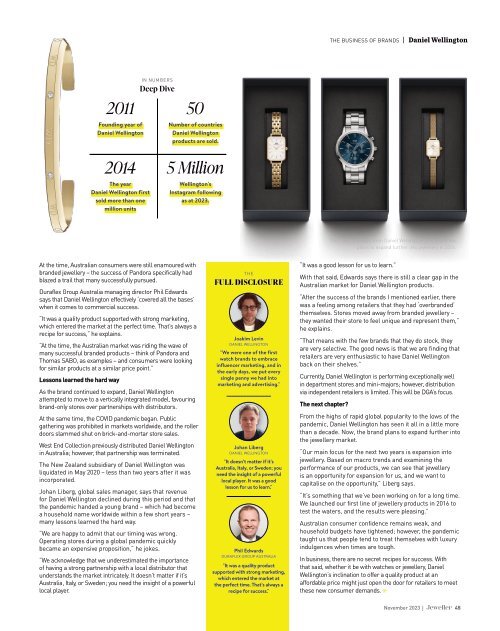Jeweller - November 2023
You also want an ePaper? Increase the reach of your titles
YUMPU automatically turns print PDFs into web optimized ePapers that Google loves.
THE BUSINESS OF BRANDS | Daniel Wellington<br />
2011<br />
Founding year of<br />
Daniel Wellington<br />
IN NUMBERS<br />
Deep Dive<br />
50<br />
Number of countries<br />
Daniel Wellington<br />
products are sold.<br />
2014<br />
The year<br />
Daniel Wellington first<br />
sold more than one<br />
million units<br />
5 Million<br />
Wellington's<br />
Instagram following<br />
as at <strong>2023</strong>.<br />
The latest releases from Daniel Wellington. The brand has<br />
plans to expand further into jewellery in 2024.<br />
At the time, Australian consumers were still enamoured with<br />
branded jewellery – the success of Pandora specifically had<br />
blazed a trail that many successfully pursued.<br />
Duraflex Group Australia managing director Phil Edwards<br />
says that Daniel Wellington effectively ‘covered all the bases’<br />
when it comes to commercial success.<br />
“It was a quality product supported with strong marketing,<br />
which entered the market at the perfect time. That’s always a<br />
recipe for success,” he explains.<br />
“At the time, the Australian market was riding the wave of<br />
many successful branded products – think of Pandora and<br />
Thomas SABO, as examples – and consumers were looking<br />
for similar products at a similar price point.”<br />
Lessons learned the hard way<br />
As the brand continued to expand, Daniel Wellington<br />
attempted to move to a vertically integrated model, favouring<br />
brand-only stores over partnerships with distributors.<br />
At the same time, the COVID pandemic began. Public<br />
gathering was prohibited in markets worldwide, and the roller<br />
doors slammed shut on brick-and-mortar store sales.<br />
West End Collection previously distributed Daniel Wellington<br />
in Australia; however, that partnership was terminated.<br />
The New Zealand subsidiary of Daniel Wellington was<br />
liquidated in May 2020 – less than two years after it was<br />
incorporated.<br />
Johan Liberg, global sales manager, says that revenue<br />
for Daniel Wellington declined during this period and that<br />
the pandemic handed a young brand – which had become<br />
a household name worldwide within a few short years –<br />
many lessons learned the hard way.<br />
“We are happy to admit that our timing was wrong.<br />
Operating stores during a global pandemic quickly<br />
became an expensive proposition,” he jokes.<br />
“We acknowledge that we underestimated the importance<br />
of having a strong partnership with a local distributor that<br />
understands the market intricately. It doesn’t matter if it’s<br />
Australia, Italy, or Sweden; you need the insight of a powerful<br />
local player.<br />
THE<br />
FULL DISCLOSURE<br />
Joakim Levin<br />
DANIEL WELLINGTON<br />
"We were one of the first<br />
watch brands to embrace<br />
influencer marketing, and in<br />
the early days, we put every<br />
single penny we had into<br />
marketing and advertising."<br />
Johan Liberg<br />
DANIEL WELLINGTON<br />
"It doesn’t matter if it’s<br />
Australia, Italy, or Sweden; you<br />
need the insight of a powerful<br />
local player. It was a good<br />
lesson for us to learn."<br />
Phil Edwards<br />
DURAFLEX GROUP AUSTRALIA<br />
"It was a quality product<br />
supported with strong marketing,<br />
which entered the market at<br />
the perfect time. That’s always a<br />
recipe for success."<br />
“It was a good lesson for us to learn.”<br />
With that said, Edwards says there is still a clear gap in the<br />
Australian market for Daniel Wellington products.<br />
“After the success of the brands I mentioned earlier, there<br />
was a feeling among retailers that they had ‘overbranded’<br />
themselves. Stores moved away from branded jewellery –<br />
they wanted their store to feel unique and represent them,”<br />
he explains.<br />
“That means with the few brands that they do stock, they<br />
are very selective. The good news is that we are finding that<br />
retailers are very enthusiastic to have Daniel Wellington<br />
back on their shelves.”<br />
Currently, Daniel Wellington is performing exceptionally well<br />
in department stores and mini-majors; however, distribution<br />
via independent retailers is limited. This will be DGA’s focus.<br />
The next chapter?<br />
From the highs of rapid global popularity to the lows of the<br />
pandemic, Daniel Wellington has seen it all in a little more<br />
than a decade. Now, the brand plans to expand further into<br />
the jewellery market.<br />
“Our main focus for the next two years is expansion into<br />
jewellery. Based on macro trends and examining the<br />
performance of our products, we can see that jewellery<br />
is an opportunity for expansion for us, and we want to<br />
capitalise on the opportunity,” Liberg says.<br />
“It’s something that we’ve been working on for a long time.<br />
We launched our first line of jewellery products in 2016 to<br />
test the waters, and the results were pleasing.”<br />
Australian consumer confidence remains weak, and<br />
household budgets have tightened; however, the pandemic<br />
taught us that people tend to treat themselves with luxury<br />
indulgences when times are tough.<br />
In business, there are no secret recipes for success. With<br />
that said, whether it be with watches or jewellery, Daniel<br />
Wellington’s inclination to offer a quality product at an<br />
affordable price might just open the door for retailers to meet<br />
these new consumer demands.<br />
<strong>November</strong> <strong>2023</strong> | 45

















